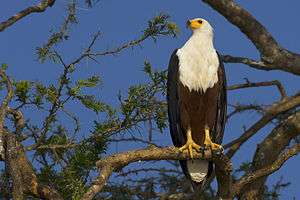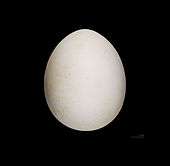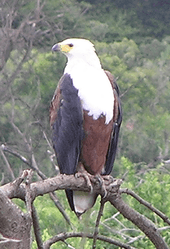African fish eagle
| African fish eagle | |
|---|---|
 | |
| Scientific classification | |
| Kingdom: | Animalia |
| Phylum: | Chordata |
| Class: | Aves |
| Order: | Accipitriformes |
| Family: | Accipitridae |
| Genus: | Haliaeetus |
| Species: | H. vocifer |
| Binomial name | |
| Haliaeetus vocifer (Daudin, 1800) | |
The African fish eagle (Haliaeetus vocifer)[2] or – to distinguish it from the true fish eagles (Ichthyophaga), the African sea eagle – is a large species of eagle that is found throughout sub-Saharan Africa wherever large bodies of open water occur that have an abundant food supply. It is the national bird of Zimbabwe, Zambia and South Sudan. As a result of its large range, it is known in many languages.[3] Examples of names include: Visarend in Afrikaans; Nkwazi in Chewa; Aigle Pêcheur in French;[4] Hungwe in Shona, and Inkwazi in isiZulu.
This species may resemble the bald eagle in appearance; though related, each species occurs on different continents, with the bald eagle being resident in North America.
Taxonomy

The African fish eagle is a species placed in the genus Haliaeetus (sea eagles). The African fish eagle's closest relative appears to be the critically endangered Madagascar fish eagle (H. vociferoides). Like all sea eagle species pairs, this one consists of a white-headed species (the African fish eagle) and a tan-headed one. These are an ancient lineage of sea eagles, and as such have dark talons, beaks, and eyes.[5] Both species have at least partially white tails even as juveniles. The scientific name is derived from Haliaeetus, New Latin for "sea eagle" (from the Ancient Greek haliaetos), and vocifer is derived from its original genus name, so named by the French naturalist François Levaillant, who called it 'the vociferous one'.[6]
Description

The African fish eagle is a large bird, and the female, at 3.2-3.6 kg (7-8 lbs) is larger than the male, at 2-2.5 kg (4.4-5.5 lbs). This is typical of sexual dimorphism in birds of prey. Males usually have a wingspan of about 2 m (6 feet), while females have wingspans of 2.4 m (8 feet). The body length is 63–75 cm (25–30 in). The adult is very distinctive in appearance with a mostly brown body and large, powerful, black wings. The head, breast, and tail of African fish eagles are snow white, with the exception of the featherless face, which is yellow. The eyes are dark brown in colour. The hook-shaped beak, ideal for a carnivorous lifestyle, is yellow with a black tip. The plumage of the juvenile is brown in colour, and the eyes are paler compared to the adult. The feet have rough soles and are equipped with powerful talons in order to enable the eagle to grasp slippery aquatic prey. While this species mainly subsists on fish, it is opportunistic and may take a wider variety of prey such as waterbirds. Its distinctive cry is, for many, evocative of the spirit or essence of Africa.[7][8][9] The call, shriller when uttered by males, is a weee-ah, hyo-hyo or a heee-ah, heeah-heeah.[8]
Distribution and habitat
This species is still quite common near freshwater lakes, reservoirs, and rivers, although they can sometimes be found near the coast at the mouths of rivers or lagoons. As their name implies, African fish eagles are indigenous to sub-Saharan Africa, ranging over most of continental Africa south of the Sahara Desert. Several examples of places where they may be resident include the Orange River in South Africa and Namibia, the Okavango Delta in Botswana, and Lake Malawi bordering its namesake country Malawi, Tanzania and Mozambique. The African fish eagle is thought to occur in substantial numbers around the locations of Lake Victoria and other large lakes that are found in Central Africa, particularly the Rift Valley lakes.[10] The African fish eagle is a generalist species, requiring only open water with sufficient prey and a good perch. This is evident by the number of habitat types that this species may be found in, including grassland, swamps, marshes, tropical rainforest, fynbos and even desert bordering coastlines,[11] such as that of Namibia. The African fish eagle is absent from arid areas with little surface water.
Reproduction

Breeding season for African fish eagles is during the dry season, when water levels are low. African fish eagles are believed to be monogamous - in other words, they mate for life.[12] Pairs will often maintain two or more nests, which they will frequently re-use. Because nests are re-used and built upon over the years the nests can grow to be quite large, some reaching 2m (six feet) across and 1.2 m (4 feet) deep. The nests are placed in a large tree and built mostly of sticks and other pieces of wood.

The female lays 1 to 3 eggs, which are primarily white with a few reddish speckles. Incubation is mostly done by the female, but the male will incubate when the female leaves to hunt. Incubation lasts for 42 to 45 days before the chicks hatch. Siblicide does not normally occur in this taxon, and the parents will often successfully rear two or three chicks. Chicks fledge at approx 70 to 75 days, Post fledgeling dependence lasts up to three months
Diet
The African fish eagle feeds mainly on fish, which it will swoop down upon from a perch in a tree, snatching the prey from the water with its large clawed talons. The eagle will then fly back to its perch to eat its catch.

Like other sea eagles, the African fish eagle has structures on its toes called spiricules that allows it to grasp fish and other slippery prey. The osprey, a winter visitor to Africa, also has this adaptation. Should the African fish eagle catch a fish over 1.8 kg (4 pounds) it will be too heavy to allow the eagle to get lift, so it will instead drag the fish across the surface of the water until it reaches the shore. If it catches a fish that is too heavy to even allow the eagle to sustain flight, it will drop into the water and paddle to the nearest shore with its wings. The African fish eagle is known to peculate other bird species (such as goliath herons) of their catch.[13] This behaviour is known as kleptoparasitism. It will also feed on waterfowl such as ducks, small turtles and terrapins, baby crocodiles, greater flamingos and lesser flamingos, lizards, frogs and carrion. Occasionally, it may even carry off mammalian prey, such as hyraxes and monkeys.[13] It has also been observed feeding on domestic fowl (chickens).
Relationship with humans
Conservation
This species is listed as Least Concern by IUCN. The estimated population size is about 300,000 individuals with a distribution area of 18,300,000 km2.[14]
Heraldry
The bird is the national bird of Zimbabwe and appears on the Zimbabwean flag. The bird figures in the Coat of arms of Namibia and the Coat of arms of Zambia. It also appears on the Coat of arms of South Sudan against two crossed bush spears and a shield.
Gallery
Footnotes
- ↑ IUCN Red List 2013.
- ↑ Etymology: Haliaeetus, New Latin for "sea eagle". vocifer, from Latin vox, "voice" + -fer, one who bears something, in allusion to the conspicuous yelping calls. These are, when sitting, given with the head fully thrown to the back, a peculiarity found among sea eagles only in this and the Madagascar species.
- ↑ "African Fish Eagle (Haliaeetus vocifer) - Birds.com: Online Birds Guide with Facts, Articles, Videos, and Photos". Birds.com. Retrieved 2012-12-12.
- ↑ "African Fish Eagle videos, photos and facts - Haliaeetus vocifer". ARKive. Retrieved 2012-12-12.
- ↑ Wink, Heidrich & Fentzloff 1996.
- ↑ Fourie, Pieter J (2010). Media Studies: Policy, Management and Media Representation. Juta and Company Ltd. p. 370. ISBN 978-0-7021-7675-3.
- ↑ http://www.wilkinsonsworld.com/tag/african-fish-eagle/
- 1 2 "Fish Eagle". The Booking Company. Retrieved 2012-12-12.
- ↑ "Art Of The Wild by Roger Brown.: Cry of the African Fish Eagle". Artofthewildrogerbrown.blogspot.com. 2011-05-10. Retrieved 2012-12-12.
- ↑ "African Fish Eagle {Haliaeetus Vocifer}". Sa-venues.com. Retrieved 2012-12-12.
- ↑ "BBC Nature - African fish eagle videos, news and facts". Bbc.co.uk. 1970-01-01. Retrieved 2012-12-12.
- ↑ http://www.wildlifeonline.co.za/bush%20school%20African%20Fish%20Eagle.htm
- 1 2 "The African fish eagle". Encounter.co.za. Retrieved 2012-12-12.
- ↑ "African Fish Eagle (Haliaeetus vocifer) - BirdLife species factsheet". Birdlife.org. Retrieved 2012-12-12.
References
- BirdLife International (2013). "Haliaeetus vocifer". IUCN Red List of Threatened Species. Version 2013.2. International Union for Conservation of Nature. Retrieved 26 November 2013.
- Wink, M.; Heidrich, P.; Fentzloff, C. (1996). "A mtDNA phylogeny of sea eagles (genus Haliaeetus) based on nucleotide sequences of the cytochrome b gene" (PDF). Biochemical Systematics and Ecology 24 (7–8): 783–791. doi:10.1016/S0305-1978(96)00049-X.
External links
- African fish eagle - Species text in The Atlas of Southern African Birds.
| Wikimedia Commons has media related to Haliaeetus vocifer. |
| ||||||||||||||||||||||||||||||||||||||||||||||||||||||||||||||||||||||||||||||||||||||||||||||||||||||||||||||||||||||||||




